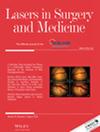Balloon-assisted laser application for endoscopic treatment of biliary stricture
Abstract
Objectives
Malignant biliary stricture is a ductal narrowing of the bile duct that is often diagnosed at an advanced stage, leading to difficulty in resection. The current study aims to evaluate the feasibility of endobiliary laser treatment by quantifying the extent of coagulative necrosis in tissue under various conditions.
Methods
Ex vivo and in vivo porcine bile tissues were used for endobiliary laser treatment to characterize the dosimetric responses of the tissue to various treatment conditions: power level, irradiation time, and number of treatments. 532 nm laser light was coupled with a balloon-integrated diffusing applicator (BDA) to deliver the laser light endoscopically for tissue coagulation. The coagulated regions (maximum length and depth) in the treated tissues were evaluated histologically for quantitative comparison.
Results
Dosimetric evaluations with ex vivo liver tissue confirmed that both maximum length and depth of coagulative necrosis (CN) increased with applied power and number of treatments. Ex vivo bile duct tests demonstrated that BDA-assisted laser treatment at 10 W for 12 s reproducibly yielded CN with a length of 5.8 ± 1.6 mm and a depth of 0.6 ± 0.2 mm. In vivo tests presented that endoscopic laser treatment using the BDA created CN on the ductal surface without any perforation. Microscopic examinations revealed that a dense inflammatory cell infiltration and eosinophilic area in the in vivo treated tissue. The extent of CN in the in vivo tissue was 40% longer and 120% deeper (length: 8.1 ± 0.7 mm; depth: 1.3 ± 0.2 mm), compared to that in the ex vivo tissue.
Conclusion
BDA-assisted laser treatment could be a feasible option for endoscopic treatment of biliary stricture with uniform ablation at the circumference of bile duct. Further in vivo studies will be performed in a large number of stricture-developed porcine models to examine both efficacy and safety of the proposed endobiliary laser treatment for clinical translations.
| 公司名称 | 产品信息 | 采购帮参考价格 |
|---|

 求助内容:
求助内容: 应助结果提醒方式:
应助结果提醒方式:


